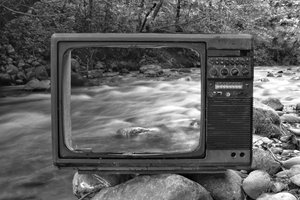Notes on Slow Disasters

“Showers $5,” read two advertisements.
The first ad hangs in New Orleans — scrawled on a cardboard sign and tied to a mailbox post, swinging back and forth in the aftermath of Hurricane Katrina. The second shines through a computer screen — posted on Craigslist during California’s water crisis.
Both images come from two separate documentaries reckoning with the human toll of climate change, investigating the concept of disaster in increasingly disastrous times. Yet, as a filmmaker, what Spike Lee’s When the Levees Broke and Marina Zenovich’s Water and Power reveals most to me is how filmmakers can make a spectacle out of climate change, socially constructing our idea of what a disaster is or is not.
After all, the difference between a disaster and everyday life is where you point the camera.

Documentaries about climate disaster offer two main challenges: one rooted in cinema, and another rooted in the social construction of disaster.
Here’s the cinematic challenge: documentaries are required to capture the world as it exists but they also have to entertain an audience. They toe a fine line between marvel-inducing spectacle and realist truth-seeking.
When talking about disasters, it is often hard to avoid the language of spectacle, and rightly so! Disasters are, often, spectacular, in a horrifyingly incomprehensible way. Scholar Gennifer Weisenfeld posits spectacles are a tool used by both producers and consumers of disaster imagery in order to grab attention, stimulate emotion, and create a shared language that lies somewhere between sight and imagination.
Filmmakers before me like to believe that people only care about the planet when there’s something disastrous to look at. But that doesn’t make for good environmental politics.
In his seminal book, Rob Nixon offers a way to think about slow disaster as slow violence. He implores his readers to call incremental, gradual, and out of sight cruelty “violence” and to “engage the representational, narrative, and strategic challenges posed by the relative invisibility of slow violence.” Documentary projects about unspectacular slow disasters could offer a way to see something that the human eye typically cannot: something unfolding so slowly as to become invisible. Systemic environmental and structural racism–processes like redlining, heavy pollution in Black and brown neighborhoods, and infrastructure disinvestment–all are slow violences. These kinds of documentary projects can offer a new way to see and know both systemic structures and acute events, sparking new ideas about preventing and recovering from the cruelty of slow violence.
By showing the social conditions and political choices before and after a disaster event, documentary films can make clear that weather events of a “hostile nature” are not the sole culprits of disasters. After all, a hurricane is not inherently bad. There’s nothing evil about rainfall or high winds. Hurricanes are bad because people are at risk for losing their lives, their homes, their family members, and their possessions. Jason W. Moore says it best: “Once we begin to ask this question — What drives today’s disastrous state of affairs? — we move from the consequences of environment-making to its conditions and causes. And once we begin to ask questions about human-initiated environment-making, a new set of connections appears. These are the connections between environment-making and relations of inequality, power, wealth, and work.”
When documentaries offer viewers a chance to grapple with the systemic power implications of disasters, they grant their audiences the opportunity to envision how they wish political and collective power was distributed before, during, and after calamity struck.
I believe that documentaries have a responsibility to communicate the collectivism that tends to reign supreme during and after disaster. If documentary films can serve both as archives of and educational tools about such resilience and social response, then they can play a constructive role in building a collective response rooted in liberation. Put another way, documentaries can validate a world that people so desparately desire to be made in its image. “The joy,” Rebecca Solnit writes of jubilant collectivism amid disaster, “matters as a measure of otherwise neglected desires, desires for public life and civil society, for inclusion, purpose, and power.”
Perhaps one day, documentary films will show that people universally have clean water, safe housing, healthy food, comprehensive healthcare, and supportive, cooperative communities. I would watch every single one of them. Until then, documentaries must not serve as spectacular advertisements for disaster.
Gennifer Weisenfeld, “Disaster as Spectacle,” Chap. 3 in Imaging Disaster (Berkeley: University of California Press, 2012).
Rob Nixon, Slow Violence and the Environmentalism of the Poor (Cambridge: Harvard University Press, 2011), 2.
As Wisner et al. state: “The crucial point about understanding why disasters happen is that it is not only natural events that cause them. They are also the product of social, political and economic environments (as distinct from the natural environment), because of the way these structure the lives of different groups of people.” Ben Wisner et al., At Risk: Natural Hazards, People’s Vulnerability and Disasters, 2nd ed. (New York: Routledge, 2004), 4.
Jason Moore, Anthropocene or Capitalocene? Nature, History, and the Crisis of Capitalism (Oakland: PM Press, 2016), 78.
Rebecca Solnit, A Paradise Built in Hell, 6.